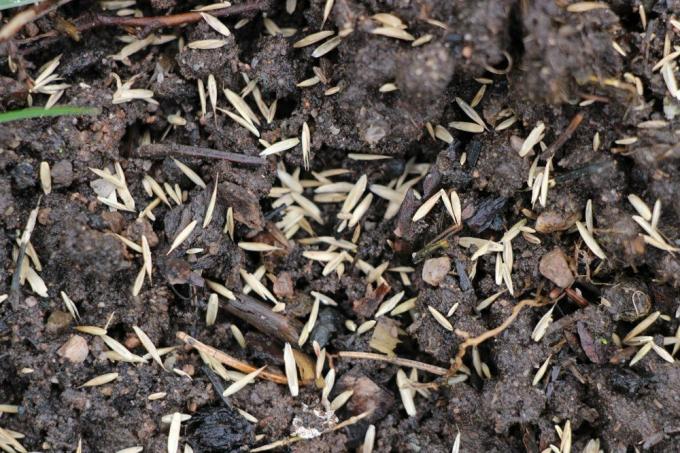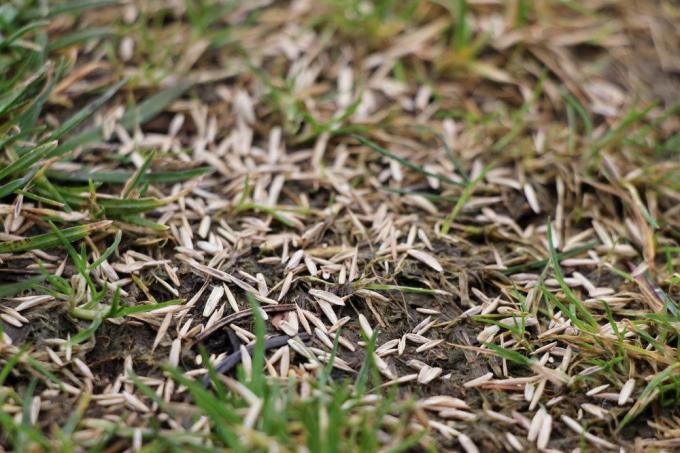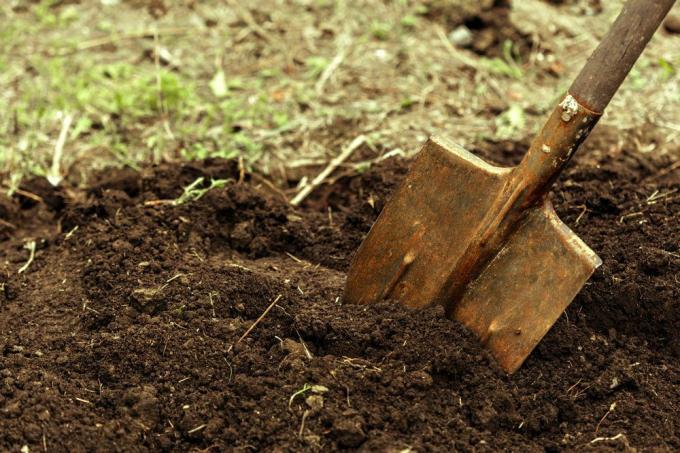
table of contents
- Sowing the lawn: soil
- Dig up the earth as deep as a spade
- Loosen heavy and sandy soil
- Settling and recompaction
- Sowing the lawn: timing
- By hand
- With the spreader
- First cut of the lawn
- Re-sow bare spots in the lawn
- Re-sow the lawn
race is not infrequently the heart of the garden. Accordingly, it should naturally look healthy and well-groomed. However, it is usually heavily used and has to endure a lot. In order to withstand the stresses, there are a few things to consider when creating a new lawn, but also when re-sowing. This applies to the quality of the seeds, the time of sowing and, in particular, good soil preparation. The soil is the basis for a healthy, fresh green lawn. This is how you sow the lawn and loosen the soil properly.
Sowing the lawn: soil
The nature of the soil plays an important role in the creation of a lawn. If it is prepared accordingly, it not only promotes the healthy development of the grass. The seeds germinate better and the maintenance of the lawn is much easier. In general, lawn grasses do not prefer hard, but rather fine, loose and well-ventilated soils. Here you can quickly develop a dense root system.
But it should not only be fine crumbly and loose, too PH value is crucial. That should be between 5.5 and 7. If it is over seven, it is advisable to work bark humus into the upper soil layers. If, on the other hand, it is lower than five, it is advisable to seal the soil about two months before sowing lime. The garden soil is often relatively hard, so that untreated it is not suitable for creating a lawn. Then it's about loosening it up accordingly.
tip: The current pH value can be easily determined with the appropriate test strips from the hardware store.
Dig up the earth as deep as a spade
Any area on which a lush green lawn will later thrive must first be dug up to a depth of at least 15 cm. This is best done a few months before sowing the lawn, ideally in autumn, when the soil is well dried and crumbly. Loosening is particularly quick and effective with a motorized milling machine. Of course, a digging fork or a conventional spade are also sufficient, it just takes a little longer. In the meantime, all weeds as well as root residues, stones and other foreign bodies are removed.
As a rule, digging can also be carried out at other times of the year. It is especially important that there is enough time between loosening and sowing so that the soil can settle again. However, this only works in connection with sufficient moisture. If there is no rain, the area must be watered intensively at least once a day.
Loosen heavy and sandy soil
It is best to start preparing the soil one to two weeks before laying the lawn. If the earth is loamy, clayey and hard, rainwater can only seep away with difficulty and the soil compacts relatively quickly. This can be remedied by adding a 1 cm thick layer of green waste compost and an approx. Work a 3 cm thick layer of sand about 10 cm deep.
In order to loosen soils that are heavily compacted and hard, a green manure, for example from oil radish and lupins, is recommended, which is applied to the area in question in early summer. In the coming winter, the plants die and decompose in the ground until the lawn is sown in September. Weeds that emerge in summer should be removed.
It looks similar with light, sandy soils. They can also be upgraded or upgraded with green waste compost or generally with plenty of compost (around 10-15 liters per square meter). loosen. On the one hand, compost enriches the soil with nutrients and also promotes the formation of humus. Work it into the top 10-20 cm.
Settling and recompaction
Settling the soil after loosening it is important so that there are no bumps or sags in the lawn later. As already mentioned, this process can take several weeks. By walking on the floor you can test to what extent it has already settled.
- It is best to wear shoes with flat heels
- Heel should not sink deeper than 1 cm
- Remove any vegetation that occurs during weaning as soon as possible
- Straighten the top two to three centimeters of the recompacted soil
- Use a wide wooden rake to level out any remaining unevenness
- Crush or remove larger clumps of earth
- Soil should have a fine crumbly structure
- Fine enough if nothing gets stuck in the tines of the rake
tip: To speed up the settling process, many hobby gardeners use the roller, which can, however, impair the growth of the grass. If you still want to take the risk, you should make sure that the floor is dry during this time.
Sowing the lawn: timing
- Sowing possible from spring to autumn
- Both new planting and reseeding
- Preferably in spring, around April and autumn
- Grasses need a minimum soil temperature of 8 ° C to germinate
- Temperatures from mid-April to early May are optimal
- Heat waves occurring in early June can damage grasses
- Therefore make sure there is sufficient moisture after sowing
- There should be no more frost during germination
- Temperatures ideally between 10 ° C and 25 ° C
- Not below 10 ° C even at night
- The day of sowing should be dry
- Reported precipitation is advantageous for the next few days
By hand
When the earth is finally settled and straightened, it can be sown. This can be done by hand or with a special spreader that can be borrowed from some hardware stores for a small fee. If you sow by hand, the seeds are usually not spread as evenly as with the spreader. Both too dense and too thin a seed density can lead to an uneven lawn appearance.
- The day of sowing should be dry and as calm as possible
- First measure the seeds required to match the lawn area
- Then spread it over the surface with a gentle swing
- If necessary, mix the seeds with some potting soil beforehand
- This means that the distribution is somewhat more even
- When sowing the lawn, proceed one square meter at a time
- Spread the seed lengthways and crossways
- Work into the soil a maximum of 1 cm
- About 25-50 g of seeds per square meter of lawn are recommended
To after the Rollers To create a good connection to the ground, you then rake with the rake once in the longitudinal direction and once in the transverse direction. In the same way you go with the roller over the surface. In rain-free weather, the whole thing now has to be watered about four times a day. The germination period is one to three weeks, depending on the weather and the type of seed.
tip: Regular and adequate watering is particularly important during and immediately after germination, because this is when the grasses are most sensitive.
With the spreader
The main advantage of sowing lawns with a spreader is that the correct amount of seed is evenly distributed over the entire area. This prevents both overdosing and underdosing. Overdosing leads to the fact that the grasses are too dense and prevent each other from growing. This also makes the lawn more susceptible to fungal diseases. If, on the other hand, too little seed is sown, no closed sward can form, there are gaps and bare spots.
In order to counteract this, one should adhere to the amounts recommended by the manufacturer. The quality of the lawn seeds plays an important role here, because the qualities of lawn seeds are sometimes very high. In order to sow, you drive the spreader in the longitudinal and transverse direction again. After sowing, the area is raked, rolled and watered or rained.
First cut of the lawn
In the first few weeks after sowing, there is a risk that seeds are still in the ground or are flying overhead Lawn weeds such as clover, plantain or dandelion settle on the area. But as soon as a dense sward has formed, this risk decreases more and more. When the grass has reached a height of eight to ten centimeters, it can be mowed for the first time. The cutting height should be five to six centimeters. As a result, the grasses begin to branch out and can form a dense sward. As a rule, the lawn can be stressed eight weeks after sowing at the earliest.
Re-sow bare spots in the lawn
Lawn is exposed to more or less heavy loads over the course of the year. So it is not surprising if one or the other bald spot appears at some point. To close these gaps, you can reseed in late summer or autumn. September is the best time, because then the soil is still warm enough for the seeds to germinate more easily. If you leave these gaps in the lawn, unwanted and sometimes stubborn lawn weeds can quickly settle.
Preparations
- Before sowing, mow the lawn as deep as possible
- Then completely remove the grass clippings
- Roughen affected areas after mowing
- Preferably with the scarifier
- The floor surface is slightly scratched
- Then remove the last remains of moss as well as dead plant and root remains
- Loosen bad soil and ensure better water drainage
- For sandy, mixing in clay powder is recommended
- Loosen heavy, loamy soils by incorporating sand
- If necessary, level again afterwards
- Fill the wells with sandy topsoil, remove elevations
Re-sow the lawn
For overseeding, fill a container with the grass seed and mix the whole thing well. Then you distribute the seeds evenly lengthways and crossways and work them into the turf. Immediately after sowing and in the first few weeks afterwards, it must be watered regularly, usually several times a day. The soil should be constantly moist. Drought, even for a short time, causes the seedlings to die off quickly. After approx. The seeds have accumulated across the board for two weeks. However, that does not mean that watering no longer has to be carried out, because constant watering is still essential until the first lawn cut.
Pay attention to high-quality lawn seeds
The best soil is useless if the lawn seeds are of inferior quality. When choosing the right seeds, the first thing that matters is the right type of lawn. The seed mixtures vary depending on the later use. For example, the grasses of a play and utility lawn have to withstand significantly more loads than, for example, an ornamental lawn, which is much more maintenance-intensive.

Shadow lawns are best for darker areas under trees and bushes.
In general, low-quality seeds require a significantly higher amount than high-quality mixtures. Cheap mixes usually germinate faster than high-quality ones. However, the latter form an even and, above all, denser sward. Even if quality seeds are a bit more expensive, you need significantly fewer seeds per square meter, which justifies the higher price. It is recommended to always use a so-called standard seed mixture. It guarantees a good mix of grass types and quality in terms of germination.





